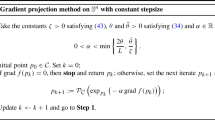Abstract
A transformation technique is proposed that permits one to derive the linear description of the imageX of a polyhedronZ under an affine linear transformation from the (given) linear description ofZ. This result is used to analytically compare various formulations of the asymmetric travelling salesman problem to the standard formulation due to Dantzig, Fulkerson and Johnson which are all shown to be “weaker formulations” in a precise setting. We also apply this transformation technique to “symmetrize” formulations and show, in particular, that the symmetrization of the standard asymmetric formulation results into the standard one for the symmetric version of the travelling salesman problem.
Similar content being viewed by others
References
J.R. Araque, “Contributions to the polyhedral approach to vehicle routing,” Ph.D. Thesis, Department of Applied Mathematics and Statistics, SUNY (Stony Brook, 1989).
A. Bachem and M. Grötschel, “New aspects of polyhedral theory,” in: B. Korte, ed.,Modern Applied Mathematics (North-Holland, Amsterdam, 1982) pp. 51–106.
E. Balas, “Notes for the Cornell University Distinguished Lecturer Series,” GSIA, Carnegie-Mellon University (Pittsburg, PA, 1987).
E. Balas and W. Pulleyblank, “The perfectly matchable subgraph polytope of a bipartite graph,”Networks 13 (1983) 495–516.
E. Balas and W. Pulleyblank, “The perfectly matchable subgraph polytope of an arbitrary graph,” Management Science Research Report No. MSRR-538, Carnegie-Mellon University (Pittsburgh, PA, 1987).
E. Burger, “Uber homogene lineare Ungleichungssysteme,”Zeitschrift für Angewandte Mathematik und Mechanik 36 (1956) 135–139.
A. Claus, “A new formulation for the traveling salesman problem,”SIAM Journal of Algebraic Discrete Methods 5 (1984) 21–25.
G. Dantzig, D. Fulkerson and S. Johnson, “Solution of a large-scale traveling-salesman problem,”Operations Research 2 (1954) 393–410.
K. Fox, “Production scheduling on parallel lines with dependencies,” Ph.D. Thesis, Johns Hopkins University (Baltimore, MD, 1973).
K. Fox, B. Gavish and S. Graves, “Ann-constraint formulation of the (time-dependent) traveling salesman problem,”Operations Research 28 (1980) 1018–1021.
D. Gale, “Convex polyhedral cones and linear inequalities,” in: Tj. Koopmans, ed.,Activity Analysis of Production and Allocation (Wiley, New York, 1951) pp. 287–297.
R. Garfinkel, “Motivation and modeling,” in: E. Lawler et al., eds.,The Traveling Salesman Problem (Wiley, New York, 1985) Chapter 2.
M. Gerstenhaber, “Theory of convex polyhedral cones,” in: Tj. Koopmans, ed.,Activity Analysis of Production and Allocation (Wiley, New York, 1951) pp. 298–316.
M. Grötschel and M. Padberg, “Polyhedral theory,” in: E. Lawler et al., eds.,The Traveling Salesman Problem (Wiley, New York, 1985) Chapter 8.
I. Heller, “On the travelling salesman problem,”Proceedings of the Second Symposium on Linear Programming, Washington, D.C., January 29, 1955.
A. Hoffman, “A generalization of max flow—min cut,”Mathematical Programming 6 (1974) 352–359.
K. Hoffman and M. Padberg, “LP-based combinatorial problem solving,”Annals of Operations Research 4 (1985/6) 145–194.
E. Johnson, “On cut-set integer polyhedra,”Cahiers du Centre de Recherche Operationelle 17 (1974) 235–251.
N. Karmarkar, “A new polynomial-time algorithm for linear programming,”Combinatorica 4 (1984) 373–395.
L.G. Khachiyan, “A polynomial algorithm in linear programming,”Soviet Mathematics Doklady 20 (1979) 191–194.
A. Lehman, “On the width—length inequality,”Mathematical Programming 17 (1979) 403–417.
C. Miller, A. Tucker and R. Zemlin, “Integer programming formulations and traveling salesman problems,”Journal of the Association for Computing Machinery 7 (1960) 326–329.
M. Padberg, “Equivalent knapsack-type formulations of bounded integer linear programs: an alternative approach,”Naval Research Logistics Quarterly 19 (1972) 699–708.
M. Padberg and Ting-Yi Sung, “An analytic symmetrization of max flow—min cut,” Preprint, Stern School of Business, New York University (New York, 1989).
J. Picard and M. Queyranne, “The time-dependent travelling salesman problem and its application to the tardiness problem in one-machine scheduling,”Operations Research 26 (1978) 86–110.
M. Simmonnard,Linear Programming (Prentice-Hall, Englewood Cliffs, NJ, 1966).
J. Stoer and C. Witzgall,Convexity and Optimization in Finite Dimensions I (Springer, Berlin, 1970).
Ting-Yi Sung, “Contributions to the travelling salesman problem and its variants,” Ph.D. Thesis, Stern School of Business, New York University (New York, 1988).
H. Weyl, “Elementare Theorie der konvexen Polyeder,”Commentarii Mathematici Helvetici 7 (1935) 290–306. [Translation in: H. Kuhn and A. Tucker, eds.,Contributions to the Theory of Games I (Princeton University Press, Princeton, NJ, 1950) pp. 3–18.]
L. Wolsey, “Strong formulations for mixed integer programming: a survey,”Mathematical Programming (Series B) 45 (1989) 173–191.
Author information
Authors and Affiliations
Additional information
Partial financial support under ONR grant No. R&T-41663 and NSF grant ECS-8615438.
Partial financial support under ONR grant No. R&T-41663.
Rights and permissions
About this article
Cite this article
Padberg, M., Sung, TY. An analytical comparison of different formulations of the travelling salesman problem. Mathematical Programming 52, 315–357 (1991). https://doi.org/10.1007/BF01582894
Received:
Revised:
Issue Date:
DOI: https://doi.org/10.1007/BF01582894




